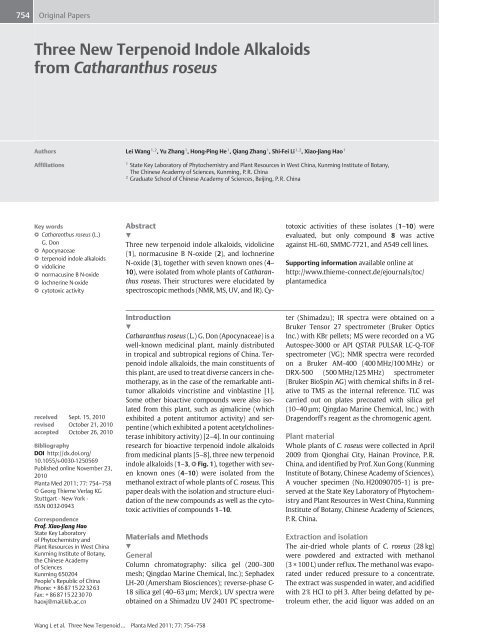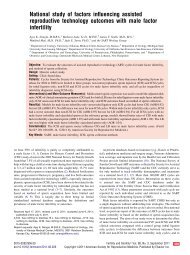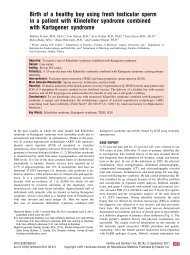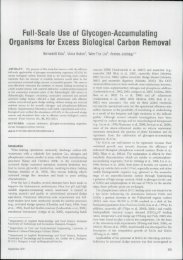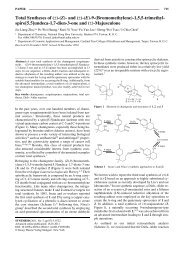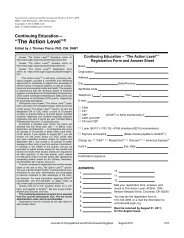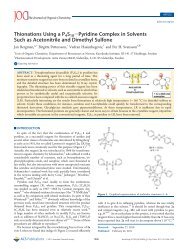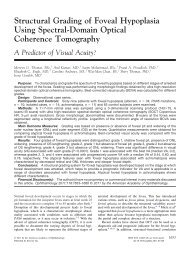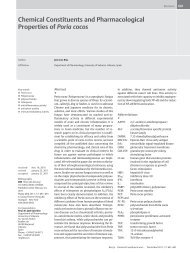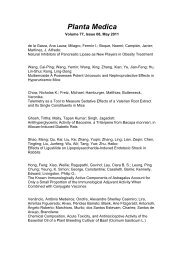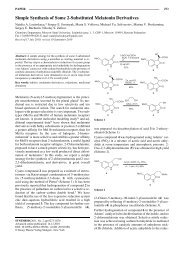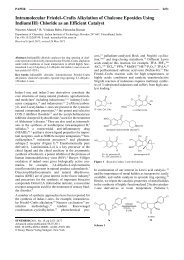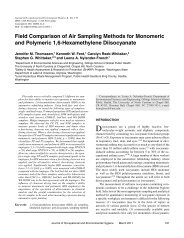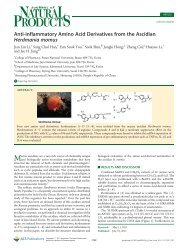Three New Terpenoid Indole Alkaloids from Catharanthus roseus
Three New Terpenoid Indole Alkaloids from Catharanthus roseus
Three New Terpenoid Indole Alkaloids from Catharanthus roseus
You also want an ePaper? Increase the reach of your titles
YUMPU automatically turns print PDFs into web optimized ePapers that Google loves.
754<br />
Original Papers<br />
<strong>Three</strong> <strong>New</strong> <strong>Terpenoid</strong> <strong>Indole</strong> <strong>Alkaloids</strong><br />
<strong>from</strong> <strong>Catharanthus</strong> <strong>roseus</strong><br />
Authors Lei Wang 1,2 , Yu Zhang 1 , Hong-Ping He 1 , Qiang Zhang 1 , Shi-Fei Li 1,2 , Xiao-Jiang Hao 1<br />
Affiliations<br />
Key words<br />
l " <strong>Catharanthus</strong> <strong>roseus</strong> (L.)<br />
G. Don<br />
l " Apocynaceae<br />
l " terpenoid indole alkaloids<br />
l " vidolicine<br />
l " normacusine B N‑oxide<br />
l " lochnerine N‑oxide<br />
l " cytotoxic activity<br />
received Sept. 15, 2010<br />
revised October 21, 2010<br />
accepted October 26, 2010<br />
Bibliography<br />
DOI http://dx.doi.org/<br />
10.1055/s-0030-1250569<br />
Published online November 23,<br />
2010<br />
Planta Med 2011; 77: 754–758<br />
© Georg Thieme Verlag KG<br />
Stuttgart · <strong>New</strong> York ·<br />
ISSN 0032‑0943<br />
Correspondence<br />
Prof. Xiao-Jiang Hao<br />
State Key Laboratory<br />
of Phytochemistry and<br />
Plant Resources in West China<br />
Kunming Institute of Botany,<br />
the Chinese Academy<br />
of Sciences<br />
Kunming 650204<br />
Peopleʼs Republic of China<br />
Phone: + 86 8715 2232 63<br />
Fax: +868715223070<br />
haoxj@mail.kib.ac.cn<br />
1 State Key Laboratory of Phytochemistry and Plant Resources in West China, Kunming Institute of Botany,<br />
The Chinese Academy of Sciences, Kunming, P.R. China<br />
2 Graduate School of Chinese Academy of Sciences, Beijing, P.R. China<br />
Abstract<br />
!<br />
<strong>Three</strong> new terpenoid indole alkaloids, vidolicine<br />
(1), normacusine B N-oxide (2), and lochnerine<br />
N-oxide (3), together with seven known ones (4–<br />
10), were isolated <strong>from</strong> whole plants of <strong>Catharanthus</strong><br />
<strong>roseus</strong>. Their structures were elucidated by<br />
spectroscopic methods (NMR, MS, UV, and IR). Cy-<br />
Introduction<br />
!<br />
<strong>Catharanthus</strong> <strong>roseus</strong> (L.) G. Don (Apocynaceae) is a<br />
well-known medicinal plant, mainly distributed<br />
in tropical and subtropical regions of China. <strong>Terpenoid</strong><br />
indole alkaloids, the main constituents of<br />
this plant, are used to treat diverse cancers in chemotherapy,<br />
as in the case of the remarkable antitumor<br />
alkaloids vincristine and vinblastine [1].<br />
Some other bioactive compounds were also isolated<br />
<strong>from</strong> this plant, such as ajmalicine (which<br />
exhibited a potent antitumor activity) and serpentine<br />
(which exhibited a potent acetylcholinesterase<br />
inhibitory activity) [2–4]. In our continuing<br />
research for bioactive terpenoid indole alkaloids<br />
<strong>from</strong> medicinal plants [5–8], three new terpenoid<br />
indole alkaloids (1–3, l " Fig. 1), together with seven<br />
known ones (4–10) were isolated <strong>from</strong> the<br />
methanol extract of whole plants of C. <strong>roseus</strong>. This<br />
paper deals with the isolation and structure elucidation<br />
of the new compounds as well as the cytotoxic<br />
activities of compounds 1–10.<br />
Materials and Methods<br />
!<br />
General<br />
Column chromatography: silica gel (200–300<br />
mesh; Qingdao Marine Chemical, Inc.); Sephadex<br />
LH-20 (Amersham Biosciences); reverse-phase C-<br />
18 silica gel (40–63 µm; Merck). UV spectra were<br />
obtained on a Shimadzu UV 2401 PC spectrome-<br />
Wang L et al. <strong>Three</strong> <strong>New</strong> <strong>Terpenoid</strong> … Planta Med 2011; 77: 754–758<br />
totoxic activities of these isolates (1–10) were<br />
evaluated, but only compound 8 was active<br />
against HL-60, SMMC-7721, and A549 cell lines.<br />
Supporting information available online at<br />
http://www.thieme-connect.de/ejournals/toc/<br />
plantamedica<br />
ter (Shimadzu); IR spectra were obtained on a<br />
Bruker Tensor 27 spectrometer (Bruker Optics<br />
Inc.) with KBr pellets; MS were recorded on a VG<br />
Autospec-3000 or API QSTAR PULSAR LC‑Q‑TOF<br />
spectrometer (VG); NMR spectra were recorded<br />
on a Bruker AM-400 (400 MHz/100 MHz) or<br />
DRX-500 (500 MHz/125 MHz) spectrometer<br />
(Bruker BioSpin AG) with chemical shifts in δ relative<br />
to TMS as the internal reference. TLC was<br />
carried out on plates precoated with silica gel<br />
(10–40 µm; Qingdao Marine Chemical, Inc.) with<br />
Dragendorffʼs reagent as the chromogenic agent.<br />
Plant material<br />
Whole plants of C. <strong>roseus</strong> were collected in April<br />
2009 <strong>from</strong> Qionghai City, Hainan Province, P. R.<br />
China, and identified by Prof. Xun Gong (Kunming<br />
Institute of Botany, Chinese Academy of Sciences).<br />
A voucher specimen (No. H20090705-1) is preserved<br />
at the State Key Laboratory of Phytochemistry<br />
and Plant Resources in West China, Kunming<br />
Institute of Botany, Chinese Academy of Sciences,<br />
P.R. China.<br />
Extraction and isolation<br />
The air-dried whole plants of C. <strong>roseus</strong> (28 kg)<br />
were powdered and extracted with methanol<br />
(3 × 100 L) under reflux. The methanol was evaporated<br />
under reduced pressure to a concentrate.<br />
The extract was suspended in water, and acidified<br />
with 2% HCl to pH 3. After being defatted by petroleum<br />
ether, the acid liquor was added on an
ion exchange resin column until the effluent was positive to<br />
Dragendorffʼs reagent. The resin was washed with water until it<br />
was neutral, then basified with 10% aq. NH3 soln. for 4 h, and finally<br />
extracted with AcOEt and MeOH, successively. The AcOEt<br />
fraction was concentrated to afford a residue of crude alkaloids<br />
(300 g).<br />
The AcOEt extract was subjected to silica gel column chromatography<br />
(∅ 10 × 90 cm) eluting with CHCl3/CH3OH (99 : 1 → 1:1) to<br />
give 5 fractions (A–E). Fraction A (42 g) was repeatedly applied to<br />
column chromatography over reverse-phase C-18 silica gel (∅<br />
3.0 × 40, 50 g) with MeOH/H2O <strong>from</strong> 1:9 to 9:1 (each 2 L), Sephadex<br />
LH-20 (∅ 1.0 × 120 cm, CHCl3/MeOH, 1: 1, 500 mL), and then<br />
silica gel (petroleum ether-Me2CO <strong>from</strong> 10:1 to 3:1, 2.4 L) to give<br />
compounds 1 (11 mg), 4 (12 mg), 7 (5 mg), 8 (92 mg), and 9<br />
(13 mg). Compounds 2 (7 mg) and 3 (8 mg) were obtained <strong>from</strong><br />
fraction B (35 g) by column chromatography (∅ 10 × 150 cm,<br />
CHCl3/CH3OH, 20 : 1, 2 L). Fraction C was also applied to repeated<br />
column chromatography (∅ 3.0 × 40 cm, reverse-phase C-18 silica<br />
gel, 50 g, MeOH/H2O, <strong>from</strong> 1: 10 to 10 : 1; then ∅ 2.0 × 30 cm,<br />
silica gel, 40 g, CH3Cl/MeOH, 10: 1; ∅ 1.0 × 120 cm, Sephadex<br />
LH-20, MeOH, 300 mL) to yield 5 (300 mg) and 6 (40 mg).<br />
Isolates<br />
Vidolicine (1): white amorphous powder (Me2CO): m.p. 140–<br />
142 °C [α] D 23 : − 8.4 (c 0.16, MeOH); UV (MeOH): λmax (log ε)=326<br />
(4.1), 296 (4.0), 222 (4.2), 204 (4.3); IR (KBr): νmax = 3441, 2924,<br />
2853, 1630, 1115, 600 cm −1 ; 1 H- and 13 C‑NMR data, see l " Table 1;<br />
EI‑MS: m/z = 352 [M] + , 323, 228, 214, 168, 154, 69; HR‑EI‑MS: m/<br />
z = 352.1807 [M] + (calcd. for C21H24 N2O3: 352.1787).<br />
Normacusine B N-oxide (2): white amorphous powder (MeOH):<br />
m.p. 270–271 °C; [α] D 21 : − 1.6 (c 0.10, MeOH); UV (MeOH): λmax<br />
(log ε) = 273 (3.3), 223 (4.0), 203 (3.9); IR (KBr): νmax = 3425,<br />
2924, 2853, 1641, 1452, 1384, 1033, 744, 594 cm −1 ; 1 H- and<br />
13 C‑NMR data, see l " Table 2; ESI‑MS: m/z = 311 [M + H] + ;<br />
HR‑EI‑MS: m/z = 310.1685 [M] + (calcd. for C19H22 N2O2: 310.1681).<br />
Lochnerine N-oxide (3): white amorphous powder (MeOH):<br />
m.p. 233–235 °C; [α] D 23 : + 22.8 (c 0.14, MeOH); UV (MeOH): λmax<br />
(log ε) = 276 (3.8), 224 (4.3), 205 (4.4); IR (KBr): νmax = 3396,<br />
3211, 2938, 1628, 1596, 1482, 1457, 1384, 1327, 1215, 1168,<br />
Table 1 1 H‑NMR (400 MHz) and 13 C‑NMR (100 MHz) data of compound 1.<br />
No. 1 a<br />
δH δC 2 – 166.8 (s)<br />
3 2.95 (1H, d, J = 3.1) 60.9 (d)<br />
5 2.88 (1H, m)<br />
2.52 (1H, m)<br />
50.6 (t)<br />
6 1.91 (1H, m)<br />
1.78 (1H, m)<br />
44.9 (t)<br />
7 – 55.0 (s)<br />
8 – 137.0 (s)<br />
9 7.16 (1H, d, J = 7.6) 121.8 (d)<br />
10 6.86 (1H, ddd, J = 7.6, 7.6, 1.0) 120.6 (d)<br />
11 7.12 (1H, ddd, J = 7.6, 7.6, 1.0) 127.7 (d)<br />
12 6.80 (1H, d, J = 7.6) 109.3 (d)<br />
13 – 143.3 (s)<br />
14 1.89 (1H, m) 38.2 (d)<br />
15 2.99 (1H, s) 61.2 (d)<br />
16 – 95.1 (s)<br />
17 2.61 (1H, d)<br />
2.35 (1H, t, J = 11.9)<br />
21.5 (t)<br />
18 1.00 (3H, t, J = 7.5) 8.7 (q)<br />
19 1.64 (2H, m) 29.5 (t)<br />
20 – 62.0 (s)<br />
21 3.35 (1H, d, J = 12.3)<br />
2.90 (1H, m)<br />
52.9 (t)<br />
COOCH3 3.78 (3H, s) 51.1 (q)<br />
COOCH3 – 168.4 (s)<br />
a δ in ppm and J in Hz<br />
Original Papers<br />
Fig. 1 Chemical structures of compounds 1–10.<br />
1144, 1032, 797, 656, 543 cm −1 ; 1 H- and 13 C‑NMR data, see l " Table<br />
2; ESI‑MS: m/z = 341 [M+H] + ;HR‑EI‑MS: m/z = 340.1788 [M] +<br />
(calcd. for C20H24 N2O3: 340.1787).<br />
Cytotoxicity assay<br />
The cytotoxicity of compounds 1–10 against HL–60, SMMC–<br />
7721, A–549, MCF–7, and SW480 human tumor cell lines was determined<br />
by the MTT method (see details in Supporting Information)<br />
[9]. Briefly, cell lines were plated in 96-well plates (10 000–<br />
Wang L et al. <strong>Three</strong> <strong>New</strong> <strong>Terpenoid</strong> … Planta Med 2011; 77: 754–758<br />
755
756<br />
Original Papers<br />
Table 2 1 H‑NMR (500 MHz) and 13 C‑NMR (125 MHz) data of compounds 2–3.<br />
No. 2a 3a δH δC δH δC 2 – 134.6 (s) – 135.3 (s)<br />
3 4.53 (1H, d, 67.7 (d) 4.50 (1H, d, 67.7 (d)<br />
J = 10.1)<br />
J = 10.2)<br />
5 3.19 (1H, t, 70.4 (d) 3.18 (1H, t, 70.4 (d)<br />
J = 6.5)<br />
J = 6.4)<br />
6 3.47 (1H, m) 24.9 (t) 3.44 (1H, m) 25.0 (t)<br />
2.84 (1H, d,<br />
2.88 (1H, d,<br />
J = 15.7)<br />
J = 15.5)<br />
7 – 102.9 (s) – 102.7 (s)<br />
8 – 128.1 (s) – 128.1 (s)<br />
9 7.46 (1H, d, 118.9 (d) 6.97 (1H, d, 101.1 (d)<br />
J = 7.8)<br />
J = 2.0)<br />
10 7.02 (1H, m) 120.3 (d) – 155.4 (s)<br />
11 7.09 (1H, m) 122.6 (d) 6.75 (1H, dd,<br />
J = 2.0, 8.8)<br />
112.6 (d)<br />
12 7.32 (1H, d, 112.2 (d) 7.21 (1H, d, 112.9 (d)<br />
J = 7.8)<br />
J = 8.8)<br />
13 – 138.5 (s) – 133.6 (s)<br />
14 2.50 (1H, t, 34.7 (t) 2.47 (1H, t, 34.7 (t)<br />
J = 12.0)<br />
J = 11.2)<br />
2.07 (1H, ddd,<br />
2.05 (1H, dd,<br />
J = 1.5, 4.0,<br />
13.0)<br />
J = 2.6, 13.0)<br />
15 2.96 (1H, t, 27.7 (d) 2.96 (1H, t, 27.7 (d)<br />
J = 2.5)<br />
J = 1.5)<br />
16 2.17 (1H, dd, 45.9 (d) 2.17 (1H, dd, 45.9 (d)<br />
J = 7.5, 14.5)<br />
J = 7.5, 14.5)<br />
17 4.35 (1H, d, 71.7 (t) 4.34 (1H, d, 71.7 (t)<br />
J = 15.8)<br />
J = 15.7)<br />
3.96 (1H, d,<br />
3.95 (1H, d,<br />
J = 15.7)<br />
J = 15.7)<br />
18 1.68 (3H, d, 13.0 (q) 1.67 (3H, d, 13.0 (q)<br />
J = 6.7)<br />
J = 6.7)<br />
19 5.54 (1H, q, 120.7 (d) 5.54 (1H, q, 120.7 (d)<br />
J = 6.7)<br />
J = 6.73)<br />
20 – 132.2 (s) – 132.2 (s)<br />
CH2OH 3.51 (2H, m) 64.0 (t) 3.65 (2H, m) 64.0 (t)<br />
OCH3 – – 3.81 (3H, s) 56.2 (q)<br />
a δ in ppm and J in Hz<br />
20000 cells/well) 12 h before treatment and continuously exposed<br />
to different concentrations of compounds (0.064, 0.32,<br />
1.6, 8, and 40 µM), and the plates were incubated at 37°C for<br />
48 h. After that, 20 µL test solution of MTT was put into each well,<br />
and the plates were incubated for an additional 4 h. Then, formazan<br />
produced was dissolved by the addition of 100 µL/well of detergent<br />
reagent, Trevogen, followed by a further incubation at<br />
37°C overnight in the dark. The optical density (OD) was measured<br />
at 595 nm using a BioTeck microplate reader against a<br />
blank prepared <strong>from</strong> cell-free cultures. Cell growth inhibition<br />
curve was graphed using the concentration as the horizontal axis<br />
and the survival rate as the vertical axis. IC50 value of each compound<br />
was calculated by the Reed and Muenchʼs method [10].<br />
Supporting information<br />
A detailed description of the structures as well as physicochemical<br />
and spectral data for compounds 4–10, along with detailed<br />
protocols for in vitro cytotoxicity assay are available as Supporting<br />
Information.<br />
Wang L et al. <strong>Three</strong> <strong>New</strong> <strong>Terpenoid</strong> … Planta Med 2011; 77: 754–758<br />
Results and Discussion<br />
!<br />
Compound 1 was obtained as a white amorphous powder and<br />
was positive to Dragendorffʼs reagent. Its molecular formula was<br />
determined as C21H24N2O3 based on HR‑EI‑MS (m/z = 352.1807<br />
[M] + ), indicating eleven degrees of unsaturation. The UV (222<br />
and 326 nm) and IR (3441 and 1630 cm −1 ) data indicated the<br />
presence of β-anilinoacrylate chromophore [11]. The 1 H‑NMR<br />
spectrum displayed 4 aromatic protons [7.16 (d, J = 7.6), 7.12<br />
(ddd, J = 7.6, 7.6, 1.0), 6.86 (ddd, J = 7.6, 7.6, 1.0), 6.80 (d, J = 7.6)],<br />
together with a broad singlet at δ H = 8.89 ppm, indicating the<br />
presence of an N-1 unsubstituted indole moiety [12]. The proton<br />
signals [δH = 1.00 (3H, t, J = 7.5), 1.64 (2H, m)] indicated the presence<br />
of an ethyl group. The 13 C‑NMR and DEPT spectra showed 21<br />
carbon atoms including one benzene ring, 2 methyl groups, 5<br />
methylene groups, 3 methine groups, 4 quaternary carbons, and<br />
1 carbonyl. These features were similar to those of pandoline [13]<br />
except that the C-15 signal (δ C = 61.2) shifted downfield suggesting<br />
that C-15 was oxygenated. In consideration of its molecular<br />
formula (C21H24 N2O3) and by comparison with the 13 C‑NMR<br />
spectrum of lochnericine (8) [14], C-15 and C-20 should be connected<br />
to an oxygen atom to form an epoxide. The presence of<br />
the key HMBC correlations of H-21 (δ H = 3.35)/C‑19 (δC = 29.5)<br />
and H-18 (δH = 1.00)/C-20 (δC = 62.0) indicated that the ethyl<br />
group was linked to C-20 (l " Fig. 2 A).<br />
By comparison of the NMR data with those of lochnericine (8), H-3<br />
was assigned to be α-oriented, and C-7 was in R*-configuration. In<br />
the ROESY spectrum, the presence of a cross-peak of H-6β/H-15<br />
indicated that H-15 was β-oriented. Because of the high tension<br />
of the three-membered ring, H-15 and the ethyl group should<br />
be cofacial. The cross-peak of H-18/H-14 indicated that the ethyl<br />
group and H-14 should also be cofacial, which showed that H-14<br />
was β-oriented (l " Fig. 2 B). Thus, the structure of compound 1<br />
was determined as shown in l " Fig. 1.<br />
Compound 2, a white amorphous powder, was also positive to<br />
Dragendorffʼs reagent. The HR‑EI‑MS (m/z = 310.1685 [M] + )<br />
showed the molecular formula C19H22 N2O2 with ten degrees of<br />
unsaturation. In 1 H‑NMR spectrum, the presence of a three-proton<br />
triplet [δH = 1.68 (3H, t, J = 6.7)] and a one proton quartet<br />
[δH = 5.54 (H, q, J = 6.7)], indicated the presence of a methylmethylene<br />
group. Four aromatic proton signals [δ = 7.46 (1H, d,<br />
J = 7.8), 7.32 (1H, d, J = 7.8), 7.09 (1H, m), 7.02 (1H, m)] and eight<br />
carbon signals [δ = 138.5 (s, C-13), 134.6 (s, C-2), 128.1 (s, C-8),<br />
122.6 (d, C-11), 120.3 (d, C-10), 118.9 (d, C-9), 112.2 (d, C-12),<br />
102.9 (s, C-7)] indicated an unsubstituted indole ring. Besides<br />
the indole ring signals, alkaloid 2 possessed 1 methyl, 4 methyl-<br />
Fig. 2 A 1 H− 1 H COSY(→) and key HMBC (H→C, arrow) correlations of<br />
compound 1; B key ROESY (arrow) correlations of 1.
enes, 6 methines, and 1 quaternary carbon. The 1 H- and 13 C‑NMR<br />
signals of 2 were close to those of normacusine B [14]. The key<br />
HMBC correlations indicated that C-3, C-5, and C-17 were all<br />
linked to N-4 (l " Fig. 3). Comparing the 13 C‑NMR spectrum with<br />
that of normacusine B [15], the downfield chemical shifts of C-3<br />
(δ = 67.7), C-5 (δ = 70.4), and C-17 (δ = 71.7) were found, indicating<br />
that 2 was an imine N-oxide. Thus, 2 was defined as normacusine<br />
B N-oxide (l " Fig. 1).<br />
Compound 3 was obtained as a white amorphous powder and<br />
positive to Dragendorffʼs reagent. Its molecular formula was determined<br />
as C 20H24 N2O3 <strong>from</strong> the HR‑EI‑MS (m/z = 340.1788<br />
[M] + ), and its NMR spectra indicated ten degrees of unsaturation.<br />
The 1 H- and 13 C‑NMR figures were very close to those of compound<br />
2 except that there were only 3 aromatic proton signals<br />
[δ = 6.75 (1H, dd, J = 2.0, 8.8), 6.97 (1H, d, J = 2.0), 7.21 (1H, d,<br />
J = 8.8)], revealing that 3 had a 1,2,4-trisubstituted benzene. The<br />
proton and carbon signals at δH 3.81 and δC 56.2 indicated an aromatic<br />
methoxy group, which should be linked to C-10 by comparison<br />
with the 13 C‑NMR spectra of lochnerine (10) [16] and confirmed<br />
by the key HMBC correlation of H‑OCH3 (δH = 3.81)/C-10<br />
(δC = 155.4) (l " Fig. 3). Accordingly, the structure of compound 3<br />
was determined as lochnerine N-oxide (l " Fig. 1).<br />
Original Papers<br />
Fig. 3 1 H− 1 H COSY(→) and key HMBC (H →C, arrow) correlations of compounds<br />
2–3.<br />
The seven known compounds were identified as deacetylvindoline<br />
(4), vindorosine (5), vindolinine (6), vincoline (7), lochnericine<br />
(8), cathovaline (9), and lochnerine (10) by comparison of<br />
their spectroscopic data with literature values.<br />
Vidolicine (1) seemed biogenetically related to pandoline [13], a<br />
known ibogamine-type alkaloid isolated <strong>from</strong> the plant Ervatamia<br />
orientalis [17], which also belongs to the Apocynaceae family.<br />
The possible biogenetic pathway was proposed as shown in<br />
l " Fig. 4. Compound 1 could be generated <strong>from</strong> geissoschizine<br />
through rearrangement and its N-oxidation, followed by Polo-<br />
Fig. 4 Possiblebiogeneticpathwayofcompound1.<br />
Fig. 5 Possible pathway of N-oxide decomposition.<br />
Wang L et al. <strong>Three</strong> <strong>New</strong> <strong>Terpenoid</strong> … Planta Med 2011; 77: 754–758<br />
757
758<br />
Original Papers<br />
novski-type reaction and then condensation to form pseudotabersonine<br />
[18]. The oxidation occurred to the double bond between<br />
C-15 and C-20 yield vidolicine (1).<br />
Compounds 2 and 3 were N-oxides, which are very common decomposition<br />
products of the corresponding tertiary alkaloids.<br />
Perivine could be one of the possible tertiary alkaloids, which<br />
had been isolated <strong>from</strong> this plant before [19]. The possible pathway<br />
of N-oxide decomposition was proposed as shown in<br />
l " Fig. 5.<br />
The cytotoxicity against HL–60, SMMC–7721, A–549, MCF–7, and<br />
SW480 human tumor cell lines of all the alkaloids above were<br />
evaluated, and only compound 8 showed moderate cytotoxicities<br />
against HL–60, SMMC–7721, and A–549, with IC50 values of 11.0,<br />
22.8, and 29.5 µM, respectively.<br />
Acknowledgements<br />
!<br />
The authors are grateful to the staffs of the analytical group at the<br />
State Key Laboratory of Phytochemistry and Plant Resources in<br />
the West China, Kunming Institute of Botany, and Chinese Academy<br />
of Sciences for measuring spectral data. This work was financially<br />
supported by grants <strong>from</strong> the Ministry of Science and Technology<br />
(2009CB940900 and 2009CB522300) and National Natural<br />
Science Foundation of China (30830114).<br />
Wang L et al. <strong>Three</strong> <strong>New</strong> <strong>Terpenoid</strong> … Planta Med 2011; 77: 754–758<br />
References<br />
1 van Der Heijden R, Jacobs DI, Snoeijer W, Hallard D, Verpoorte R. The<br />
<strong>Catharanthus</strong> alkaloids: pharmacognosy and biotechnology. Curr Med<br />
Chem 2004; 11: 607–628<br />
2 Usia T, Watabe T, Kadota S, Tezuka Y. Cytochrome P450 2D6 (CYP2D6)<br />
inhibitory constituents of <strong>Catharanthus</strong> <strong>roseus</strong>. Biol Pharm Bull 2005;<br />
28: 1021–1024<br />
3 Singh DK, Srivastava B, Sahu A. Spectrophotometric determination of<br />
Rauwolfia alkaloids: estimation of reserpine in pharmaceuticals. Anal<br />
Sci 2004; 20: 571–573<br />
4 Pereira DM, Ferreres F, Oliveira JMA, Gaspar L, Faria J, Valentão P, Sottomayor<br />
M, Andrade PB. Pharmacological effects of <strong>Catharanthus</strong> <strong>roseus</strong><br />
root alkaloids in acetylcholinesterase inhibition and cholinergic neurotransmission.<br />
Phytomedicine 2010; 17: 646–652<br />
5 Zhou H, He HP, Kong NC, Wang TJ, Hao XJ. <strong>Indole</strong> alkaloids <strong>from</strong> the<br />
leaves of Anthocephalus chinensis. Helv Chim Acta 2008; 91: 2148–<br />
2152<br />
6 Zhou H, He HP, Kong NC, Wang YH, Liu XD, Hao XJ. <strong>Three</strong> new indole alkaloids<br />
<strong>from</strong> the leaves of Kopsia officinalis. Helv Chim Acta 2006; 89:<br />
515–519<br />
7 Zhou H, He HP, Luo XD, Wang YH, Yang XW, Di YT, Hao XJ. <strong>Three</strong> new<br />
indole alkaloids <strong>from</strong> the leaves of Alstonia scholaris. Helv Chim Acta<br />
2005; 88: 2508–2512<br />
8 Zhang Z, Di YT, Wang YH, Mu SZ, Fang X, Zhang Y, Tan CJ, Zhang Q, Yan<br />
XH, Guo J, Li CS, Hao XJ. Gelegamines A–E: five new oxindole alkaloids<br />
<strong>from</strong> Gelsemium elegans. Tetrahedron 2009; 65: 4551–4556<br />
9 Monks A, Scudiero D, Skehan P, Shoemaker R, Paull K, Vistica D, Hose C,<br />
Langley J, Cronise P, Vaigro W. Feasibility of a high-flux anticancer drug<br />
screen using a diverse panel of cultured human tumor cell lines. J Natl<br />
Cancer Inst 1991; 83: 757–766<br />
10 Reed LJ, Muench H. A simple method of estimating fifty percent endpoint.<br />
Am J Hyg 1938; 27: 493–497<br />
11 Weissberger I, Taylor EC. <strong>Indole</strong>s: the monoterpenoid indole alkaloids.<br />
<strong>New</strong> York: Wiley-Interscience; 1983: 357<br />
12 Wenkert E, Cochran DW, Hagaman EW, Schell FM, Neuss N, Katner AS,<br />
Potier P, Kan C, Plat M, Koch M, Mehri H, Poisson J, Kunesch N, Rolland Y.<br />
Carbon-13 nuclear magnetic resonance spectroscopy of naturally occurring<br />
substances. XIX. Aspidosperma alkaloids. J Am Chem Soc<br />
1973; 95: 4990–4995<br />
13 Bruneton J, Cavé A. The carbon-20 stereochemistry of pandoline and<br />
epipandoline. Tetrahedron Lett 1976; 17: 3567–3570<br />
14 Éles J, Kalaus G, Greiner I, Kajtár-Peredy M, Szabó P, Keserû GM, Szabó L,<br />
Szántay C. Synthesis of vinca alkaloids and related compounds. 100.<br />
Stereoselective oxidation reactions of compounds with the aspidospermane<br />
and quebrachamine ring system. First synthesis of some alkaloids<br />
containing the epoxy ring1a. J Org Chem 2002; 67: 7255–7260<br />
15 Jokela R, Lounasmaa M. 1 H- and 13 C‑NMR spectral data of five sarpagine-type<br />
alkaloids. Heterocycles 1996; 43: 1015–1020<br />
16 Abaul J, Philogène E, Bourgeois P, Mérault G, Poupat C, Ahond A, Potier P.<br />
Alcaloïdes indoliques de Rauvolfia biauriculata. J Nat Prod 1986; 49:<br />
829–832<br />
17 Bruneton J, Cavé A. The carbon-20 stereochemistry of pandoline and<br />
epipandoline. Tetrahedron Lett 1976; 39: 3567–3570<br />
18 Wang FP. The alkaloid chemistry. Beijing: Chemical Industry Press;<br />
2008: 305<br />
19 Marvin G, Janice S. Perivine. Tetrahedron Lett 1964; 42: 3105–3111


